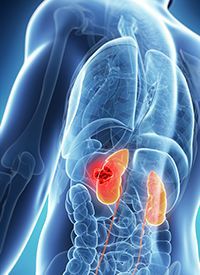Optimizing Adjuvant Therapy in Renal Cell Carcinoma
Patients with high-risk renal cell carcinoma who harbor early systemic dissemination with very poor survival prognosis may derive some benefit from adjuvant therapy.

Patients with high-risk renal cell carcinoma (RCC) who harbor early systemic dissemination with very poor survival prognosis may derive some benefit from adjuvant therapy.
Adjuvant therapy is associated with high toxicity and most patients will derive no benefit, Umberto Capitanio, MD, San Raffaele Scientific Institute, Milan, Italy, said in a presentation during the 2017 EMUC Congress. However, adjuvant therapy “might show the highest ratio between clinical benefit and toxicity” in this specific subset of high-risk patients.
“Lymph node dissection in the high-risk M0 scenario does remain a key tool to identify the best candidates for adjuvant therapy,” he said. “This can be the small but important proportion of patients who might benefit from adjuvant therapy.”
A few days before Capitanio’s presentation, the FDA approved sunitinib (Sutent) as an adjuvant therapy in patients with RCC who have received nephrectomy and are at high risk for recurrence. European guidelines do not recommend adjuvant therapy in this population, and Capitanio sought to explain why the use of adjuvant therapy is controversial in RCC.
Capitanio summarized results from 3 phase III trials exploring adjuvant therapy in high-risk RCC: S-TRAC, ASSURE, and PROTECT.
S-TRAC showed that adjuvant sunitinib prolonged disease-free survival (DFS) by 1.2 years compared with placebo (6.8 vs 5.6 years; hazard ratio [HR], 0.76; 95% CI, 0.59-0.98; P = .03) following nephrectomy for patients with high-risk clear cell RCC. In higher risk patients, the median DFS was 6.2 versus 4.0 years for sunitinib and placebo, respectively (HR, 0.74; 95% CI, 0.55-0.99; P = .04). The FDA approved sunitinib based on these results.1
Adjuvant treatment produced negative results in the other 2 trials. Median DFS was 5.8 years for sunitinib in the ASSURE trial, 6.16 years for sorafenib (Nexavar), and 6.6 years for placebo. There was also significant treatment discontinuation due to toxicity, despite dose reduction.2
In PROTECT, Robert J. Motzer, MD, and colleagues concluded that 600 mg of adjuvant pazopanib (Votrient) did not significantly improve DFS compared with placebo (HR, 0.86; 95% CI, 0.70 to 1.06; P = .165). Furthermore, increased ALT (16%) and AST (5%) were common adverse events leading to treatment discontinuation.3
Capitanio said 2 issues might explain the differing results: 1) the timing of baseline imaging and the start of adjuvant therapy and 2) whether physicians are looking for patients who will benefit from adjuvant therapy.
He noted that the timing of imaging and treatment initiation was different for each trial. Treatment in S-TRAC, which produced positive results, began within 3 to 12 weeks of nephrectomy. “They received immediate negative baseline imaging because no metastases were evident, and then the patients started therapy.”
In ASSURE, imaging was performed within 3 months of removal of the primary tumor. Baseline imaging to exclude metastases was performed a minimum of 1 month after nephrectomy in the PROTECT trial.
Capitanio said that the natural history of very high-risk, nonmetastatic patients—similar to those included in the 3 trials—treated at San Raffaele Scientific Institute, showed that 20% demonstrated metastatic progression within 3 months.
Patients in S-TRAC were treated immediately after surgery, meaning that patients with early recurrence disease as well those with a false-negative metastatic status were included in the trial. Conversely, those patients were more likely to be excluded in the ASSURE and PROTECT trials, reducing the positive effect of adjuvant therapy.
“Those are probably the patients who are going to benefit the most from adjuvant therapy,” Capitanio told the audience.
Capitanio said this brief post-nephrectomy therapeutic window was important because patients who are going to recur following surgery are going to have poor natural history of disease.
Capitanio looked at the inclusion criteria for S-TRAC to identify the ideal patient for this treatment. Using the UISS classification criteria, 37% of patients were determined to have intermediate-risk, nonmetastatic disease, while 55% had high-risk, nonmetastatic disease.
However, there is a subset that was nonmetastatic at nephrectomy, but under the UISS system, patients with lymph node invasion without distant metastases are considered metastatic. Only 8% of those patients were included in the trial, but Capitanio said this population may benefit from adjuvant treatment.
“We know that if we take high-risk patients, namely T3 and T4, the lymph node invasion is between 27% and 32%,” he said.
He said the rate of lymph node dissection is low in the United States and Europe because published results have shown there is no survival benefit associated with the procedure. “That is why we’re not finding patients with lymph node invasion,” said Capitanio.
References
- Ravaud A, Motzer RJ, Pandha HS, et al. Adjuvant Sunitinib in High-Risk Renal-Cell Carcinoma after Nephrectomy [published online October 10, 2016]. N Engl J Med. doi: 10.1056/NEJMoa1611406.
- Hass NB, Manola J, Uzzo RG, et al. Adjuvant sunitinib or sorafenib for high-risk, non-metastatic renal-cell carcinoma (ECOG-ACRIN E2805): a double-blind, placebo-controlled, randomised, phase 3 trial. Lancet. doi: 10.1016/S0140-6736(16)00559-6.
- Motzer RJ, Hass NB, Donskov F, et al. Randomized phase III trial of adjuvant pazopanib versus placebo after nephrectomy in patients with localized or locally advanced renal cell carcinoma. J Clin Oncol. doi: 10.1200/JCO.2017.73.5324.
Manali Kamdar, MD, on a Large Scale Analysis of CRS/ICANS in Patients Receiving Liso-Cel
June 2nd 2025Manali Kamdar, MD, the associate professor of medicine–hematology and clinical director of lymphoma services at the University of Colorado, an analysis of more than 1,500 patients treated with liso-cel across clinical trials and the real world.









